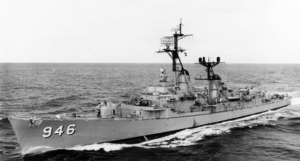Up through the early 1980s, those serving at Charleston Navy Shipyard risked exposure to asbestos, which can lead to serious health issues later in life. Many U.S. Navy veterans, shipyard workers, and others at the yard have gone on to develop mesothelioma, a cancer only caused by asbestos. We can help veterans, civilians, and family members after a mesothelioma diagnosis.
What to Know About Asbestos at Charleston Naval Shipyard
Located in South Carolina, Charleston Naval Shipyard serviced vessels for nearly 100 years until its closure in 1996.
For most of the shipyard’s history, veterans and civilians working there unknowingly put their lives in danger. This is because virtually all Navy ships serviced at Charleston Naval Shipyard contained a toxic substance called asbestos.
The use of asbestos was mandated aboard all U.S. Navy ships for decades, but exposure is now known to cause cancers like mesothelioma.
Charleston Naval Shipyard and Mesothelioma Quick Facts
- Also known as: Charleston Navy Yard, Charleston Navy Base, Charleston Naval Complex
- Ships serviced: Destroyers, submarines, minesweepers, and many more
- Health risks: Mesothelioma, lung cancer, and other asbestos-related diseases
- Time period of asbestos use: 1930s to the early 1980s
- Who is at risk: Navy veterans, shipyard workers, civilians, and family members
If you or someone you love worked at Charleston Naval Shipyard decades ago and now has mesothelioma, we may be able to help you pursue military benefits, treatments, and compensation.
Get a Free Veterans Packet now to see all the ways we can assist you and your family.
How Was Asbestos Used in Charleston Naval Shipyard?
Asbestos was a popular material used in the shipbuilding industry due to its ability to resist fire, water, heat, and corrosion.
In fact, government mandates required every U.S. Navy ship to contain asbestos materials.
Ships serviced at Charleston Navy Shipyard may have used asbestos in:
- Boiler rooms and engine rooms: Asbestos was used in these areas as they were often exposed to high temperatures, pressure, and moisture.
- Gaskets and valves: These components relied on asbestos for increased durability in the face of heat and steam pressure.
- Insulation: Asbestos insulation was found throughout electrical systems, piping systems, and more.
Additionally, the dry docks and buildings at Charleston Navy Shipyard may have also relied on asbestos for durability, insulation, and fireproofing.
List of Ships Built or Repaired at Charleston Naval Shipyard
Over 250 U.S. Navy ships were constructed at Charleston Naval Yard and many more were stationed and serviced there.
Building and renovating Navy ships released asbestos fibers and dust into the air, putting those nearby at risk of exposure.
Examples of ships built or worked on at Charleston Navy Shipyard included:
- Destroyers: Dozens of destroyers were stationed at the shipyard during World War II and beyond, including the USS Ringgold (DD-500) and USS Strong (DD-758).
- Minesweepers: The USS Agile II (MSO-421), Alacrity III (MSO-523), USS Avenge II (AM-423), and USS Pigeon II (AM-374) were all serviced at Charleston Naval Shipyard.
- Submarines: The USS Proteus III (AS-19) notably underwent a significant overhaul at the Charleston Yard in 1959, with a 44-foot-plug installed so the vessel could transport and service missiles. The USS Holland (AS-32), USS Tunny II (SSN-682), and many more nuclear submarines underwent renovations there.
Hundreds of thousands of people were employed at Charleston Navy Yard throughout the decades — and anyone exposed to asbestos at the site could now be in danger of mesothelioma.
Call (877) 450-8973 for help pursuing benefits if you or a loved one was diagnosed with mesothelioma and served at Charleston Navy Yard.
Jobs at Risk of Asbestos Exposure at Charleston Naval Shipyard
Because asbestos was so prominent at Charleston Naval Shipyard, virtually all shipyard workers and Navy service members were in danger of exposure.
However, those at the highest risk worked directly with or around asbestos-containing materials every day.
High-risk occupations for asbestos exposure included:
- Carpenters
- Electricians
- Fireproofers
- Insulators
- Machine operators
- Mechanics
- Pipefitters
- Repairmen
- Welders
- Woodworkers
As the risks of asbestos became public knowledge, Navy vessels were required to undergo renovations to remove the fibers. However, there was no way to lower the health risks in those already exposed.
Many former Charleston Naval Shipyard workers have since gone on to develop mesothelioma and other serious illnesses.
Benefits and Compensation for Charleston Naval Shipyard Victims
Help and benefits are available to former Charleston Naval Shipyard workers suffering from mesothelioma and other asbestos-related illnesses.
VA Benefits for Mesothelioma
The U.S. Department of Veterans Affairs (VA) provides many different benefits to veterans with mesothelioma. Veterans with this cancer typically receive a 100% disability rating, meaning they can receive the highest payouts available.
Mesothelioma VA benefits include:
- Disability compensation worth $4,044.91 monthly as of 2025
- Free or low-cost medical care for mesothelioma with VA health care
- Other resources for surviving loved ones
We can assist you or a veteran you love in getting the mesothelioma VA benefits you deserve.
Charleston Naval Shipyard Mesothelioma Lawsuits
Veterans and civilians may qualify to file mesothelioma lawsuits and seek compensation from companies that made and sold asbestos-containing products.
Mesothelioma lawsuits award $1 million or more on average. No legal action is taken against the military or government.
Our legal partners have recovered millions of dollars for other veterans in South Carolina.
Key South Carolina mesothelioma payouts include:
- $3 million for a U.S. Air Force veteran and flight engineer
- $1.72 million to a U.S. Coast Guard veteran and electrician
- $2.76 million for a U.S. Navy veteran and ironworker
Get a free case review now to learn if you’re able to file a mesothelioma lawsuit and receive the compensation you deserve.
Asbestos Trust Funds
Many manufacturers of asbestos-containing products filed for bankruptcy in an attempt to avoid legal liability. However, they were forced by the court system to set aside huge sums of money in trusts to pay those who were harmed.
There’s more than $30 billion available in asbestos trusts today. Our team may be able to help you access compensation from any trusts that you qualify for.
Help for Charleston Naval Shipyard Asbestos Exposure
Hundreds of thousands of people were employed at Charleston Naval Shipyard, and many have gone on to develop mesothelioma, lung cancer, and other asbestos-related diseases.
The Mesothelioma Veterans Center may be able to help you or a loved one after a diagnosis.
Our team can assist with:
- Accessing mesothelioma VA benefits
- Connecting with key treatments and doctors
- Pursuing compensation for medical bills
Get a Free Veterans Packet now or call (877) 450-8973 to see how our team can make living with this aggressive cancer easier.
Charleston Naval Shipyard & Asbestos Exposure FAQs
What Navy ships have asbestos?
Virtually every U.S. Navy ship built before the early 1980s had asbestos, including many that were built or serviced at Charleston Naval Shipyard.
The USS Ringgold (DD-500), USS Agile II (MSO-421), USS Strong (DD-758), and USS Proteus III (AS-19) were just a few of many vessels once stationed at Charleston Naval Shipyard that contained asbestos.
Working with or around these vessels put Navy veterans and shipyard workers at risk of mesothelioma 10-50 years later.
What happened to the Charleston Naval Shipyard?
Charleston Naval Shipyard closed in 1996 after the demands of shipbuilding decreased in the post-Cold War era.
While Charleston Naval Shipyard is no longer in operation, many former workers and U.S. veterans are still facing the consequences of their service there. This is because those exposed to asbestos at the shipyard decades ago are just developing mesothelioma in the present day.
Contact us now for help if you or a loved one has been diagnosed with mesothelioma.
Are shipyard workers exposed to asbestos?
Yes, shipyard workers at Charleston Naval Shipyard and across the country were exposed to asbestos for decades.
Any shipyard worker who served prior to the early 1980s could have suffered exposure from asbestos-containing products like insulation, piping, gaskets, and more.
What year did the Navy stop using asbestos?
The U.S. Navy stopped using asbestos in the early 1980s and steps were taken to remediate all existing vessels.
However, for Navy veterans and Charleston Naval Shipyard workers already exposed, it was too little too late, as there’s no way to lower the risk of developing mesothelioma or other asbestos-related diseases.



